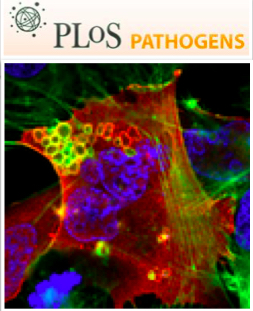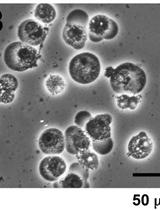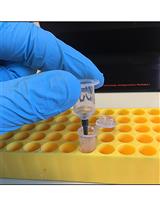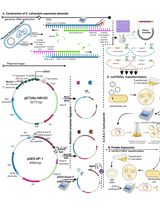- EN - English
- CN - 中文
Preparation of Respiratory Syncytial Virus with High or Low Content of Defective Viral Particles and Their Purification from Viral Stocks
使用高或低含量防御病毒颗粒制备呼吸道合胞体病毒并从病毒原液中对其纯化
发布: 2016年05月20日第6卷第10期 DOI: 10.21769/BioProtoc.1820 浏览次数: 18608
评审: Yannick DebingChang Ho LeeDavid Paul
Abstract
Respiratory syncytial virus (RSV) belongs to the paramyxovirus family that includes many clinically relevant viruses, such as the human metapneumovirus and measles. RSV infection can cause severe disease in infants, the elderly, and some immunocompromised adults. During RSV replication, a series of truncated forms of the viral genome is generated. These truncated viral genomes are known as defective viral genomes (DVGs) and are generated by many viruses (Lazzarini et al., 1981; Rao and Huang, 1982; Prince et al., 1996; Sun et al., 2015; Tapia et al., 2013). DVGs can restrict the replication of the full-length virus and are the primary natural triggers of the innate immune response to RSV (Sun et al., 2015; Tapia et al., 2013). Here we discuss in detail how to prepare RSV stocks with a high or low content of DVGs, and how to purify defective viral particles containing DVGs from an RSV stock enriched in defective viral particles. These procedures are useful for the preparation of viral stocks and defective viral particles necessary for laboratory research. In brief, the different RSV stocks are produced in HEp2 cells, which are commonly used to amplify this virus in the laboratory. To generate an RSV stock with a high content of DVGs, HEp2 cells are sequentially infected with a high multiplicity of infection (MOI) multiple times followed by purification of the viral particles containing DVGs using gradient centrifugation. The procedure describe here has four parts: 1. Amplification of seed RSV stock with a low DVG content (RSV-LD), 2. Generation of a stock with a high DVG content (RSV-HD), 3. Purification of DVGs by gradient centrifugation, 4. Characterization of purified DVGs.
Keywords: Respiratory syncytial virus (呼吸道合胞病毒)Materials and Reagents
- Sterile polypropylene conical 15 and 50 ml tubes (BD, Falcon®, catalog number: 352070 , or equivalent)
Note: Currently, it is “Corning, Falcon®, catalog number: 352070 ”. - Disposable cell scraper (Thermo Fisher Scientific, catalog number: 08-100-241 )
- Sterile screw-cap microtubes, 2 ml (SARSTEDT AG & Co., catalog number: 15071353 )
- Sterile, aerosol-resistant micropipette tips (1-1,000 μl capacity) (Eppendorf AG or equivalent)
- Cotton-plugged, sterile serological pipettes (1-25 ml capacity) (Eppendorf AG or equivalent)
- Straight-neck polystyrene tissue culture flasks with vented caps, 75 cm2 (Bioexpress, catalog number: T-3001-2 ) and 225 cm2 (BD, FalconTM, catalog number: 353139 )
Note: Currently, it is “Corning, Falcon®, catalog number: 353139”. - Polystyrene tissue culture plates with lids 12 (Greiner Bio-One GmbH, catalog number: 665180 ) and 96 (Greiner Bio-One GmbH, catalog number: 655086 )
- 0.22 μm filter for pipette aid (VWR International, catalog number: 28145-481 )
- Vacuum-driven Stericup® 500 ml Millipore ExpressPLUS 0.22 μm PES (Merck Millipore Corporation, model: SCGPU05RE )
- Ultra-centrifuge tubes
- HEp2 cells (ATCC, catalog number: CCL-23 )
- Human RSV strain A2 (ATCC, catalog number: VR-1540 )
- Mycoplasma removal agent (MP BioMedical, catalog number: 093050044-5 ml )
- Dulbecco’s modified eagle medium (DMEM) (Life Technologies, catalog number: 11995073 )
Note: Currently, it is “Thermo Fisher Scientific, GibcoTM, catalog number: 11995073”. - UltraPureTM EDTA (0.5 M) (Gibco, catalog number: 15575 )
Note: Currently, it is “Thermo Fisher Scientific, InvitrogenTM, catalog number: 15575”. - Trypsin-EDTA, 0.25% (wt/vol) (Thermo Fisher Scientific, GibcoTM, catalog number: 25300054 )
- Fetal bovine serum (FBS), heat-inactivated at 56 °C for 30 min (Thermo Fisher Scientific, catalog number: 10082-147 )
Note: Aliquots should be stored at -20 °C and thawed before use. - Gentamicin reagent solution (Thermo Fisher Scientific, GibcoTM, catalog number: 15750-060 )
- Sodium pyruvate solution (Thermo Fisher Scientific, InvitrogenTM, catalog number: 11360070 )
- L-glutamine (Thermo Fisher Scientific, InvitrogenTM, catalog number: 25030-081 )
- Hanks’ balanced salt solution (HBSS) (Thermo Fisher Scientific, GibcoTM, catalog number: 14025-092 )
- Phosphate-buffered saline (PBS) (pH 7.4) (Thermo Fisher Scientific, GibcoTM, catalog number: 10010056 )
- Ethanol (Thermo Fisher Scientific, DeconTM, catalog number: 64-17-5 )
- Methanol (HPLC) (Thermo Fisher Scientific, Fisher Scientific, catalog number: A452 )
- Crystal violet (Thermo Fisher Scientific, catalog number: C581 )
- Dry ice
- Thermo ScientificTM GeneRulerTM 100 bp Plus DNA Ladder 100 to 3,000 bp (Thermo Fisher Scientific, catalog number: FERSM0322 )
- Electrophoresis, loading dyes, Thermo Scientific, 6x DNA loading dye (Thermo Fisher Scientific, Thermo ScientificTM, catalog number: R0611 )
- UltraPure agarose (Thermo Fisher Scientific, InvitrogenTM, catalog number: 16500-500 )
- Tris-acetate-EDTA (TAE), 10x (Thermo Fisher Scientific, InvitrogenTM, catalog number: 15558026 )
- D-sucrose (Sigma-Aldrich, catalog number: BP220 )
Note: Currently, it is “Thermo Fisher Scientific, catalog number: BP220”. - Gelatin, from bovine skin (Sigma-Aldrich, catalog number: G9391 )
- Superscript® III first-strand synthesis system (Thermo Fisher Scientific, InvitrogenTM, catalog number: 18080-051 )
- Platinum Taq DNA polymerase (Thermo Fisher Scientific, InvitrogenTM, catalog number: 10966018 )
- TRIzol reagent (Thermo Fisher Scientific, AmbionTM, catalog number: 15596018 )
- dNTP set (100 mM) (Thermo Fisher Scientific, InvitrogenTM, catalog number: 10297117 )
- PierceTM coomassie plus (Bradford) protein assay (Thermo Fisher Scientific, catalog number: 23236 )
- RT-PCR primers
- DI1 primer: 5’-CTTAGGTAAGGATATGTAGATTCTACC-3’
- gRSV/DI primer: 5’-CCTCCAAGATTAAAATGATAACTTTAGG-3’
- DI1 primer: 5’-CTTAGGTAAGGATATGTAGATTCTACC-3’
- Regular tissue culture medium (TCM) (see Recipes)
- Infection medium (see Recipes)
- PNE buffer (see Recipes)
- 20% sucrose (see Recipes)
- 0.1% Gelatin in PBS (see Recipes)
- 1% crystal violet stock solution (see Recipes)
- Crystal violet working solution (see Recipes)
Equipment
- Class II biological safety cabinets
- Approved BSL-2 or enhanced BSL-2 laboratory facilities
- Personal protective equipment (PPE)
- Spray bottles for 70% (vol/vol) ethanol
- Micropipettes (1-1,000 μl capacity), multiple channel pipettes (1-200 μl capacity)
- Pipette controller (VWR International)
- Vortex mixer
(Thermo Fisher Scientific)
- Water bath, 37 °C
(Thermo Fisher Scientific)
- Refrigerated table-top centrifuge (for 15 ml and 50 ml conical tubes) (Eppendorf AG, model: 5810R )
- OptimaTM L-90K ultracentrifuge (Beckman Coulter, catalog number: 365670 )
- SW 32 Ti rotor package, swinging bucket (fit for 25 x 89 mm tube) (Beckman Coulter, catalog number: 369694 )
- SW 41 Ti rotor package, swinging bucket (fit for 14 x 89 mm tube) (Beckman Coulter, catalog number: 331362 )
- Gradient Master (BioComp Instruments Inc., catalog number: 107-201M )
- Freezers and refrigerators: -80 °C, -20 °C, and 4 °C
- Tissue culture incubator (37 °C, 5-7% CO2) (Thermo Fisher Scientific)
- Cell counter
- Cell culture microscope (Nikon Corporation or equivalent)
- Microwave
- Glass Erlenmeyer flask (500 ml)
- Agarose gel casting tray (Thermo Fisher Scientific)
- Electrophoresis chamber (Thermo Fisher Scientific)
- Power supply (Thermo Fisher Scientific)
- UV light box (Thermo Fisher Scientific)
- Gel DocTM XR+ gel imaging system (Bio-Rad Laboratories)
- NanoDrop 1000 spectrophotometer (Thermo Fisher Scientific)
- VariokanTM Flash Multimode Reader (Thermo Fisher Scientific)
Procedure
文章信息
版权信息
© 2016 The Authors; exclusive licensee Bio-protocol LLC.
如何引用
Readers should cite both the Bio-protocol article and the original research article where this protocol was used:
- Sun, Y. and López, C. B. (2016). Preparation of Respiratory Syncytial Virus with High or Low Content of Defective Viral Particles and Their Purification from Viral Stocks. Bio-protocol 6(10): e1820. DOI: 10.21769/BioProtoc.1820.
- Sun, Y., Jain, D., Koziol-White, C. J., Genoyer, E., Gilbert, M., Tapia, K., Panettieri, R. A., Hodinka, R. L. and Lopez, C. B. (2015). Immunostimulatory Defective Viral Genomes from Respiratory Syncytial Virus Promote a Strong Innate Antiviral Response during Infection in Mice and Humans. Plos Pathogens 11(9).
分类
微生物学 > 微生物生物化学 > 蛋白质 > 分离和纯化
您对这篇实验方法有问题吗?
在此处发布您的问题,我们将邀请本文作者来回答。同时,我们会将您的问题发布到Bio-protocol Exchange,以便寻求社区成员的帮助。
Share
Bluesky
X
Copy link












